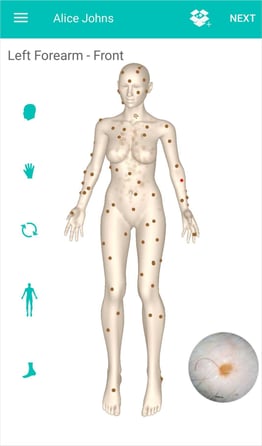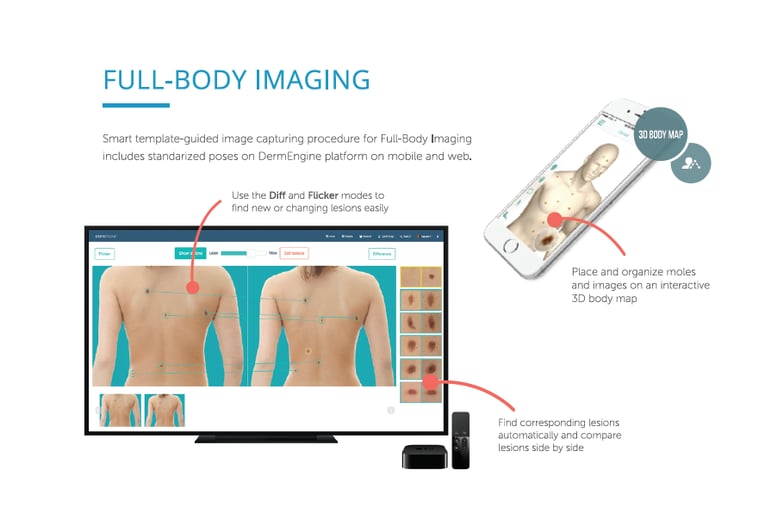How Has Total Body Photography Evolved? Pain Points Then And Now
Total Body Photography: although only implemented within the past couple of decades, it has become a pillar for dermatology practices focused on the early detection of skin cancer. Introduced in a time of rapidly evolving technology, how has it improved and what goals remain unachieved?
The History of Total Body Photography
In order to understand what’s missing in total body photography (also known as TBP, full-body imaging or whole body pictures), we must first go back to the 1990’s when the entire imaging process was comprised of a patient standing against a blank wall with a staff member taking photos using a flash camera.
From this point, the film was developed and then stored in the patient’s medical record, where it would sit on a shelf exposed to the elements (dust, direct sunlight, mold, water damage) until a follow up visit in the coming months or years. After the subsequent visit, the images would be compared side-by-side or on a slide projector to examine any potential changes to the patient’s skin over time.
The Present
As technology progressed, image storage upgraded from floppy disks, to CDs, and finally to USB sticks in the 2010’s. Similarly, the use of film-based cameras was replaced with a variety of more advanced options, namely the digital camera, smartphones, and imaging booths- each with their own unique benefits. In all of these cases, the patient is imaged with files most typically stored on a dermatology EMR software, where a nurse or other healthcare provider is instructed to prioritize dermoscopic images for closer inspection. Alternatively, many cloud-based dermatology software automatically upload the images to eliminate timely uploads and streamline the process.
When the patient arrives for their next session, the imaging technician may use a silhouette or template to ensure the patient poses in as similar of a position as possible to their previous images to simplify the comparison process. Once complete, the dermatologist will examine the images for any changes. Dermatology software focused on best practice solutions provide a mole matching feature within their services, which automatically detects differences between chronological images while prioritizing them from greatest to least amount of change to support the dermatologist in identifying suspicious changes to the patient’s skin.
What’s Still Missing?
Although total body photography has been witness to incredible advancements over the last 20 years, it is far from perfected. Three key areas in need of improvement include:
1.Security: The use of emails, texting, and fax machines create vulnerable points in the chain of communication that cannot be risked when such sensitive data is involved. All systems and communication methods must be regulated and protected with the proper security measures to ensure private, secure services.
2.Image Identification: Photos are lost or misplaced, and spots are misidentified on subsequent visits, leading to inaccurate information. To resolve this error, dermatologists must be able to store and access images in a refined manner, such as a 3D Body Map with clickable spots which take the user directly to previously taken images for maximized efficiency.
3. Interoperability: Healthcare systems remain disconnected; although the technology is available, many practices are still taking images, manually uploading them, and transferring them between systems for storage and USBs for patient review. To work, systems must be interoperable in order to make way for a simple, accessible, centralized solution.
Total body photography services have become a valuable solution for the early detection of skin cancer through its ability to effectively image the majority of a patient’s skin in a short period of time. Already over twenty years old, this technology has been repeatedly updated to match the current needs of patients and dermatology staff. However, that isn’t to say it is without flaw; data security, organization and interoperability remain key needs that have yet to be adequately addressed, yet must be tended to if total body photography is to become a more widespread solution for effectively skin cancer early detection and care.
-The MetaOptima Team
Would you like to stay updated on the latest news of MetaOptima and its dermatology EMR solution, DermEngine? Subscribe to our blog below! If you're ready to experience DermEngine's intuitive features for yourself, sign up for a demo today!
Topics: Total Body Imaging Total Body Photography Full Body Imaging Dermatology EMR Software Total Body Photography Software MoleMap MoleMatch 3D Body Map EMR Solutions TBP






